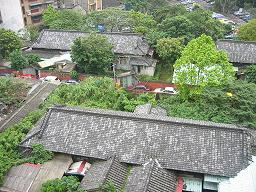Japanese Era Dormitories Designated Historical Site

The Japanese era wooden dormitories located at the intersection of Guling Street and Fuzhou Street (“Nan Cai Yuan”) was approved by the Taipei City Council as a historical site of Taipei City on July 5. The collection of dorms, which sit right across from the Ministry of Finance, once housed important officials during the Japanese pre-war era. Some of the famous residents have included the principals of the Taipei Imperial University (today’s National Taiwan University [NTU]) and the presidents of the Bank of Taiwan, which is one of the oldest banks on the island. Currently, with the exception of one building among the group, the wooden dormitories are relatively well-preserved. The entire vicinity is walled off and covers an area of approximately 1,300 pings. The building was vacated by the last inhabitants in 2004. According to city planning documents during the Japanese era, this area was designated to house top officials in the educational, financial, and political sectors. One street away from the Bank of Taiwan dormitories is the old dormitories of NTU. In addition to the old residence of the famous philosophy professor, Thome H. Fang, this was also the residence of Taipei Imperial University’s principals. According to the Department of Cultural Affairs, due to the constant interactions between the University’s principal and the Japanese Viceroy’s Office during the colonial period, Nan Cai Yuan was chosen as the site of the official residence due to the proximity. Even today, NTU still continues the practice of having its acting principal reside in the school-owned dormitory during their tenure. The original city plans were drafted by the Japanese ruler to help the fledging city centers on the north and south of downtown. The dorms for the government officials were constructed along Zhongshan North Road (such as Shuanglian), while the residence for officials of the Viceroy’s Office were built from Nanchang Road southward. Former Viceroy Kodama Gentaro’s residence once stood at the location of Nanchang Park. Today, the buildings provide one of the best testimonies to the urban development history of southern Taipei during this period. The area is now one of several tree-lined tranquil places that can be found around the city.



